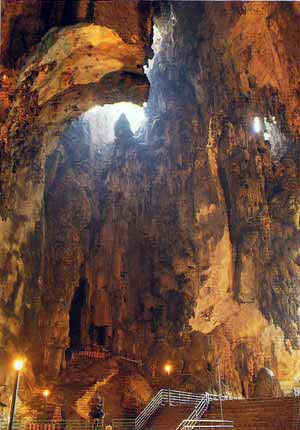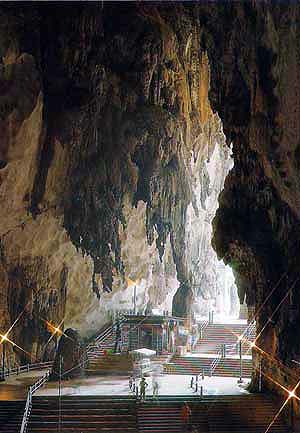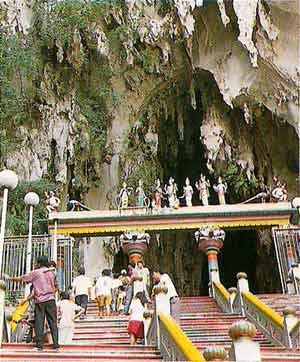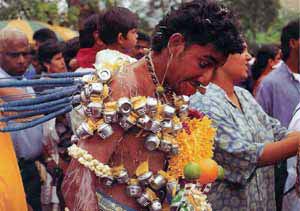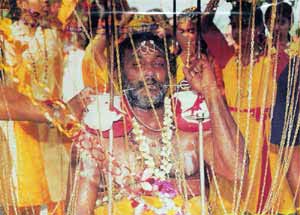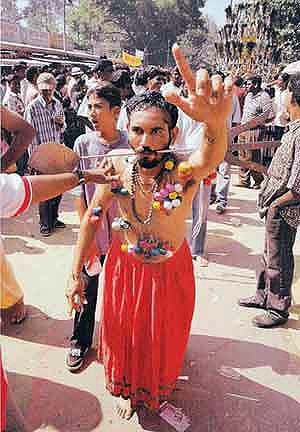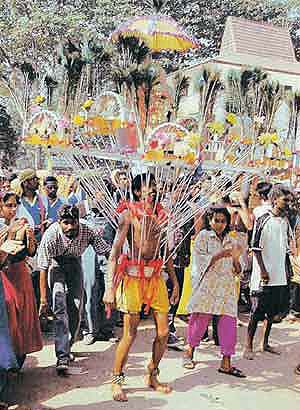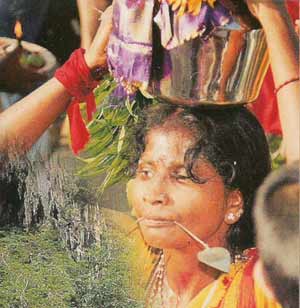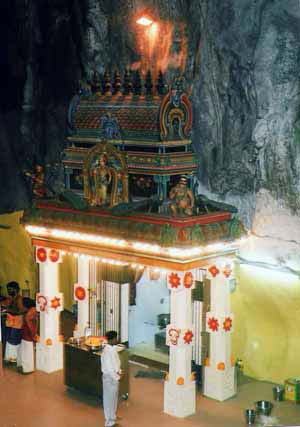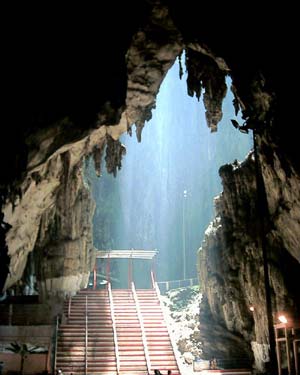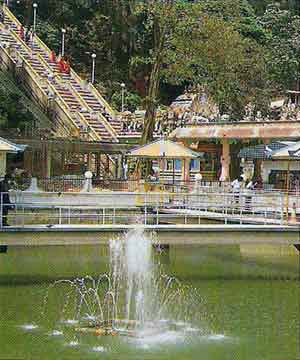
|
||||||||||||||||
|
| ||||||||||||||||
Batu Caves Śrī Subramaniar Swamy Devasthanam
R. NadarajaIntroductionThe Batu Caves Temple in Malaysia stands out as a monumental focal point of the significant contribution made by the Indian settlers in the development of Malaya and then Malaysia (1963). The 113 year old main temple, dedicated to Lord Subramaniar (Karttikeya), is lodged in a cave about 400 feet above ground level. It is the main cave, the temple cave, in a hilly massif known as Bukit Batu, Rocky Hill. The name is derived from the name of a nearby river known as Sungai Batu, Rocky River in the Malay Language, the National Language of Malaysia. Arrival of the TamilsDevotion, cultural heritage and love for the Tamil Language are the priorities for the Tamil Race. Wherever they reach, together they bring those fundamental qualities. The life-style of the Tamils is situated around the surroundings of temple shrine. They strongly believe that their life is destined by the supreme power. Within the four seas, they travelled to search for fortune. In the 18th and 19th century, Malaya (now Malaysia) was no optional. The ancestors who came here, brought along with them the Divine Mother - Śrī Maha Mariamman and his "Gnana Kulantai", Śrī Subramaniar to be worshipped and prayed for their protection. Thus Śrī Maha Mariamman Temple was built in 1873 in Kuala Lumpur. In 1891, K. Thambusamy Pillai, an influential descendent of Indian immigrants from Tamilnadu, India, the founder President of the Śrī Maha Mariamman Temple in Kuala Lumpur, installed the murti (consecrated statue) of Śrī Subramania Swamy in what is today known as the Temple Cave. Since 1892, the Thaipusam festival in the Tamil month of Thai (which falls in late January/early February) has been celebrated there. ThaipusamThaipusam is grandiose affair! It attracts about a million worshippers and tourists from within the country and abroad over three days of festivities. Nowhere else in the world (not even India) is this festival celebrated on such a grand scale. Thaipoosam or Thaipusam falls annually on the full- moon day in the Tamil month of Thai which occurs between January 14th and February 15th. This is when the moon moves through the zodiac period of Cancer according to the Indian Calender. The day also marks the day on which Lord Siva danced with His Consort Uma and the day on which Karttikeya (Murugan, Subramaniam and, the numerous other names by which is known to His devotees) received the divine spear, Vel, from His Mother. He is greatly adored by Tamilians all over the world. Throngs of people begin to converge at the Śrī Maha Mariamman Temple in Kuala Lumpur and Batu Caves on the eve of Thaipusam. The murti of Śrī Subramaniar Swamy which resides in the Kuala Lumpur temple throughout the rest of the year, is bathed and elaborately decorated on the eve; and, on the following day, Thaipusam, a bullock drawn chariot winds its way through the city on its way to the Temple Cave - an annual journey to mark the occasion. The gleaming, elaborately lit, silver chariot towers to an awe inspiring 21 feet above ground level. The chariot stops at several points along its journey to allow gatherings of devotees to offer prayers and smash coconuts on the roads as a mark of the supremacy of good over evil. Vow FulfilledFor a period of a fortnight to a month, the devotee who has vowed to do penance observes fasts on prescribed days. The devotee partakes of only vegetarian food, abstains from all forms of self-indulgence and remains chaste and clean in word, thought and deed. The devotee lives in seclusion or in the company of other fasting devotees. From well before sunrise on the day of the festival, devotees with chests, backs, thighs, foreheads, tongues and cheeks pierced with silver needles or skewers, carry contraptions called kavadi. The kavadi may be simple wooden arched semi-circular supports holding a carrier foisted with brass or clay pots of milk or huge, heavy ones which may rise up to two metres, built of bowed metal frames which hold long skewers, the sharpened end of which pierce the skin of the bearers torso. The kavadi is decorated with flowers and peacock feathers imported from India. Some kavadi may weigh as much as a hundred kilograms. After a bath in the nearby Sungei Batu (Rocky River), the devotees wend their way to the Temple Cave and with remarkable endurance they climb the flights of stairs to the temple in the cave. Devotees use the wider centre staircase while worshippers and onlookers throng up and down those balustrades off on either side. When the kavadi bearer arrives at the foot of the 272 step stairway leading up to the Temple Cave, the devotee has to make the arduous climb against gravity- against the press of the bustling masses. Once the kavadi bearers reach the Cave Temple, they offer prayers to the murti of the Lord Murugan who is now in the residence at the Temple Cave after His Chariot journey from Kuala Lumpur. Priests attend to the kavadi bearers. Consecrated ash is sprinkled over the hooks and skewers piercing the devotees flesh before they are removed. No blood is shed during the piercing and removal. Batu Caves - A Tourist ParadiseBatu Caves, as it is popularly known, is located about 12 km north of Kuala Lumpur, the capital of Malaysia. It is nestled close to the main highways leading to the northern parts and the eastern coast of Peninsular Malaysia. When the caves were in a pristine state before 1860, several of the 18 cave mouths were used by the indigenous Besisi people as transit shelters when they went out hunting from their jungle hamlets. As early as 1860, Chinese settlers began excavating guano for fertilising their vegetable patches. It was only in 1878 that British Europeans came upon the complex of hills while on a hunting trip. Behind the cupolas on the zigzag bridge (foreground) is the staircase leading up to the Temple Cave. The landings are designed for viewing the scenery from different heights and for the aged and infirm to rest before continuing on the next flight. The landings offer a grand view of the lush scenery from various heights. On a clear sunny day, the topmost landing offers a view of the fortress-walled range of hills enclosing suburban Kuala Lumpur townships sprawling over the fertile floor of the valley. The western coast of the Peninsular where the emerald sea rolls into the Bay of Bengal lies beyond the green, forest clad range of hills. A flight of 272 steps leads up to the temple. The stairway is divided into steps which each lead to a landing. Along the balustrade of the staircase and at some of the landings that offer the least competition from their fellows, the resident long-tailed macaques hang around unceremoniously for treats from visitors. The generously fed flocks of pigeons swamp the courtyard before the ground level portal of the temple. The pigeons are tame and they give way to passing visitors graciously. Apart from the annual Thaipusam festival, tourist and devotees visit Batu Caves regularly. Throughout the year, the Temple Caves attract between 3,000 to 5,000 people daily. At the base of the hill, at the ground level, there are three caves with statuary and mural depictions of scenes from the Ramayana, Mahabharat and the lives of renowned Tamil poets. The three caves are known as the Valluvar Kottam, Art Gallery and the Ramayana Cave. The depictions are spectacularly graphic. The Ramayana Cave presents a concise but comprehensive narration of Lord Rama's history. Valluvar Kottam and Art Gallery CavesA short walk along a zigzag bridge over a pond teeming with fish, terrapin and tortoises brings the visitor to Valluvar Kottam and Art Gallery Caves. Quaint cupolas at the angles of the zigzag bridge provide shade where the visitor could stop to watch or feed the teeming aquatic life. The cave walls of the Vallurvar Kottam are covered with statuary exhibits, murals and inscriptions of the poet's couplets. The exhibits are used to illustrate relevant couplets from the Tirukkural, his entire works. Valluvar Kottam is so lit that the atmosphere of a silent cave is well preserved. Not to miss is the statue of the five-legged bull. The owner of this freak, five-legged bull gave it away to the Batu Caves Temple soon after it was born. The fifth leg of the bull grew from the back near the bull's hump. In all other respects the bull was healthy and roamed freely around the temple grounds as long as it lived among a harem of cows. It died a natural death after spending its entire life on the temple grounds. The Ramayana CaveThe Ramayana Cave occurs to the extreme left as one faces the sheer wall of the hill. On the way to the Ramayana Cave, 50 foot tall murti of Hanuman and a temple dedicated to Hanuman, the noble monkey devotee and aide of Lord Rama. The consecration ceremony of the temple was held on November 2001. The Ramayana Cave depicts the story of Ramar in a chronicle manner quite effectively. The Cave is well lit and allows the visitor to stroll leisurely viewing the depictions along the irregular walls of the cave. One might experience the feeling that one is strolling through the giant intestines of the mighty demon, Kumbhakarann, brother of King Ravana of Lanka. The Dark CaveThe hill massif is also home to the primitive Trapdoor spider, Liphistius Batuensis, which is in danger of extinction. It is believed that the Batu Caves are the only place left in the world where this spider species still exists. Naturalists fear that this rare spider might face the same fate as the serow, a species of mountain goats, last seen in 1989 and, which might have been hunted out of existence in this area. The Dark Cave which occurs at a point along the stairway leading to the Temple Cave, is still a pristine state. Cave formations and crystals carved and moulded by the hands of Nature remain untouched by the destructive hands of man. Various species of fauna abound in this cave. Guided tours into the cave may be arranged through the Malaysian Nature Society whose brochure describing this cave is readily available from tourist agencies. ConclusionBatu Caves, a 400 million year-old limestone hill with beautiful stalactites and stalagmites, is nature's wonder. The massif and its caves shelter a variety of flora and fauna - some are so rare that they may only be found in this place. Together with that wonder, it is also the government recognised religious and cultural centre for the Indians and Hindus in this country. Major plans are ahead to erect a complete temple ground for the followers of all Hindu deities to facilitate their worship. Śrī Sundraswarar Temple is being erected at left end of the foothill. Śrī Venkatasalapati Temple is being constructed at the entrance of the Ramayana Cave. A three-storey multi-purpose hall is well built at the entrance of Batu Caves Temple to cater for cultural and religious activities. The temple grounds adjoining the massif sprawl over an area of 16 acres of flat land. A Tamil School run by the Śrī Maha Mariamman Temple Devasthanam is built on the grounds which also house several eateries which serve a delicious variety of vegetarian Southern Indian Food. Batu Malai Śrī Subramaniar Temple is managed by the Board of Management of Śrī Maha Mariamman Temple Devasthanam (performing the role of Hindu Religious Consultant to the Government of Malaysia in determining the Hindu yearly calendar), which also manages the Śrī Ganesar Temple at Court Hill. Under construction is the statue of Lord Muruga at the entrance of the steps and once completed will stand at 130 feet tall, making it the tallest Lord Muruga statue in the world. R. Nadaraja, KMN, AMN, PJK.
|
